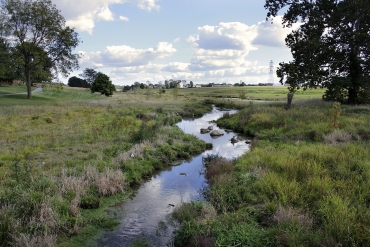Landis Homes Stream and Floodplain Restoration

Kurtz Run flows through the Landis Homes campus and is a tributary to the Conestoga River. Before the project, degradation was clear with eroding stream banks adding sediment and nutrients to the stream. The project removed legacy sediment from the floodplain, which builds up over centuries of intensive land use, altering the natural course of a stream and burying floodplains and wetlands. As a result of sediment removal, floodwater storage potential was increased and buildable land previously used for conventional stormwater basins could instead be used for building 11 new residential units. In addition, the project reduced stream bank erosion and created 5.7 acres of wetlands with over 700 trees and shrubs, and 25,600 herbaceous plugs (grasses, rushes, sedges) planted in the area.
The initial goals of the project were to provide a regional opportunity for multiple benefits including improved water quality, flood storage capacity, bio-diversity and community aesthetics while increasing the space available for housing. Kelly Gutshall, president and landscape architect at LandStudies, Inc., said these goals were not only met, but exceeded. Overall, the project has resulted in an annual reduction of 802 pounds of nitrogen, 133 pounds of phosphorus, and 75 tons of sediment. The benefits for Landis Homes and its residents are immeasurable.
Before the floodplain restoration at Landis Homes was underway, residents were concerned about the view and asked for a planted screen to hide the wetland that was under construction. Now, they wouldn’t dream of hiding the wetland that now flourishes with new flora and fauna.
Home to more than 700 residents, the Landis Homes retirement community in Lititz, Pennsylvania needed additional living space to meet demand for an increasing number of retirees. Landis Homes and their land development consultant RGS Associates contacted LandStudies, Inc., a local landscape architect firm specializing in floodplain restoration and regional stormwater solutions, for help. The team felt that restoring the floodplain would not only provide an amenity for the community, but also improve water quality and provide a unique stormwater management solution for the development. Over the course of three months, the team designed a stream and floodplain restoration project that improved stream function, increased floodwater storage potential, and actively engaged residents to improve social interactions and overall community health. By utilizing the floodplain for stormwater management, land that would be typically set aside for conventional stormwater management basins was used to construct additional housing units, increasing the efficiency of the overall development.
The restored floodplain and resulting wetland habitat have become a hub of activity for the community and the wildlife that call it home. Residents regularly post photos on social media of native plants and migratory birds sightings. Residential interest, however, goes well beyond the visual aesthetic. A group who calls themselves “Friends of the Woods and Wetlands” formed to help oversee and protect this special part of their community, even going as far as creating an inventory of the vegetation and monitoring the existence of invasive plants. This group of retired teachers and scientists are interested in the ecosystem services and functional benefits of the restoration. They frequently request LandStudies for monitoring data because they want to better understand the project and ultimately expand the bio-diversity by introducing new wildlife. The group is hoping to introduce spring peepers, a type of frog that thrives in wooded areas and grassy lowlands. Beginning in the spring, the frogs create a chorus of tiny croaks that echo throughout the wetlands they inhabit.
Another resident, seeing the habitat the wetland provided, brought his bee colony for which the carpentry group at Landis Homes built bee boxes. “Friends of Woods and Wetlands” are trying to establish a local bee population. Project leaders from LandStudies did not plan for this kind of initiative, but the residents took the project and ran with it. “The residents have taken ownership of the wetland and natural areas,” said Gutshall. According to Gutshall, some residents even moved to the community because of the wetlands. Many residents are retired biology teachers and professors who are naturally interested in the ecosystem that has developed there since the project was implemented.
Another element of the project residents enjoy is the trail that runs through the wetland. It connects the retirement community with the barn and garden plots nearby, along with a trail that leads to the grocery store. It’s only about 200-300 ft. long, but residents frequently ride their scooters and bikes on it and enjoy being outside. The trail is also used for frequent tours of the grounds and serves as a site for the Chesapeake Bay Landscape Professional (CBLP) certification field practicums, a program aimed at training contractors and design professionals in sustainable landscape installation.
For more information about this project, visit our case story map: https://mostcenter.org/case-story-content/landis-homes-stream-and-flood….
Legacy Sediment
Sediment that eroded from upland areas after the arrival of early settlers and during centuries of intensive land use. This nutrient-rich sediment deposited in valley bottoms along stream corridors, burying pre-settlement streams, floodplains, wetlands, and valley bottoms. Legacy sediment continues to impair the hydrologic, biologic, aquatic, riparian, and water quality functions of modern environments today.
-Source: PA Department of Environmental Protection
